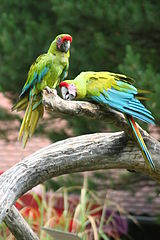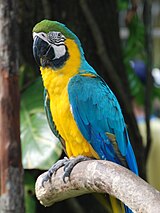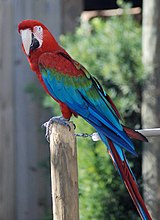Template:Ara genus table
Jump to navigation
Jump to search
| Ara | |||
|---|---|---|---|
| Common and binomial names[1] | Image | Description | Range[2] |
| Great green macaw or Buffon's macaw (Ara ambiguus) |
85–90 cm (33–36 in) long. Mostly green, red on forehead, green and blue wings[3] | Central and South America, from Honduras to Ecuador | |
| Blue-and-yellow macaw or blue-and-gold macaw (Ara ararauna) |
80–90 cm (31.5–35.5 in) long. Mostly blue back and yellow front. Blue chin and green forehead. The upper zone of the bare white skin around each eye extending to the beak is patterned by lines of small dark feathers. | Panama, Colombia through to south-central Brazil. | |
| Green-winged macaw or red-and-green macaw (Ara chloroptera) |
90 cm (36 in) long. Mostly red, with blue and green wings. The bare white skin around each eye extending to the bill is patterned by lines of small red feathers. | South America, from Colombia through to northern Paraguay (formerly northern Argentina) | |
| Blue-throated macaw (Ara glaucogularis) |
75–85 cm (30–34 in) long. Blue upperparts and mostly yellow lowerparts, blue throat. Areas of pale skin on the sides of the face are covered with lines of small dark-blue feathers, with pinkish bare skin at the base of the beak.[4] | North Bolivia | |
| Scarlet macaw (Ara macao) |
81–96 cm (32–36 in) long. Mostly bright red, with red, yellow and blue in the wings. There is bare white skin around the each eye extending to the bill. | Mexico to Colombia and the Amazon Basin. | |
| Military macaw (Ara militaris) |
70 cm (28 in) long. Mostly green, red forehead[5] | Discontinuous distribution in Mexico and along the Andes from Venezuela to north Argentina. | |
| Red-fronted macaw (Ara rubrogenys) |
55–60 cm (21.5–23.5 in) long. Mostly green. red forehead and red patch over the ears, pinkish skin on the face, red at bend of wings, blue primary wing feathers[6] | Central Bolivia | |
| Chestnut-fronted macaw or severe macaw (Ara severa) |
46 cm (18 in) long. Mostly green, chestnut forehead, red at bend of wings | Panama and South America in the Chocó and Amazon Basin | |
| †Cuban macaw (Ara tricolor) Extinct ca. 1885 |
50 cm (20 in) long. Red forehead fading to orange and then to yellow at the nape of the neck, dark brown bill paler at the tip; orange face, chin, chest, abdomen and thighs; upper back mainly brownish red, and the rump and lower back blue; brown, red and purplish-blue wing feathers; upper surface of the tail was dark red fading to blue at the tip, and brownish red underneath.[7] | Extinct - formerly endemic on Cuba and probably also on Isla de la Juventud (previously called the Isle of Pines).[7] | |
| †Lesser Antillean macaw or Guadeloupe macaw (Ara guadeloupensis) Extinct |
Tail feathers 15–20 inches long. Similar colour as the scarlet macaw, but smaller with an entirely red tail. Known from descriptions and possibly paintings and subfossils. | Extinct - Guadeloupe | |
| †St. Croix macaw (Ara autocthones) Extinct |
Only known from sub-fossil bones found at two archeological sites.[8] | Extinct - Saint Croix, U.S. Virgin Islands and central Puerto Rico | |
Usage
| This template's documentation is missing, inadequate, or does not accurately describe its functionality and/or the parameters in its code. Please help to expand and improve it. |
References
- ↑ "Zoological Nomenclature Resource: Psittaciformes (Version 9.004)". www.zoonomen.net. 2008-07-05.
- ↑ Collar N (1997) "Family Psittacidae (Parrots)" in Handbook of the Birds of the World Volume 4; Sandgrouse to Cuckoos (eds del Hoyo J, Elliott A, Sargatal J) Lynx Edicions:Barcelona. ISBN 84-87334-22-9 pp.420-425
- ↑ "Species factsheet: Ara ambiguus". BirdLife International (2008). Retrieved 24 July 2008.
- ↑ "Species factsheet: Ara glaucogularis". BirdLife International (2008). Retrieved 24 July 2008.
- ↑ "Species factsheet: Ara militaris". BirdLife International (2008). Retrieved 24 July 2008.
- ↑ "Species factsheet: Ara rubrogenys". BirdLife International (2008). Retrieved 24 July 2008.
- ↑ 7.0 7.1 Fuller, Errol (1987). Extinct Birds. Penguin Books (England). pp. 148–9. ISBN 978-0-670-81787-0.
- ↑ Olson, Storrs L.; Edgar J. Máiz López (2008). "New evidence of Ara autochthones from an archeological site in Puerto Rico: a valid species of West Indian macaw of unknown geographical origin (Aves: Psittacidae)" (PDF). Caribbean Journal of Science. 44 (2): 215–222.
| The above documentation is transcluded from Template:Ara genus table/doc. (edit | history) Editors can experiment in this template's sandbox (create | mirror) and testcases (create) pages. Please add categories to the /doc subpage. Subpages of this template. |










